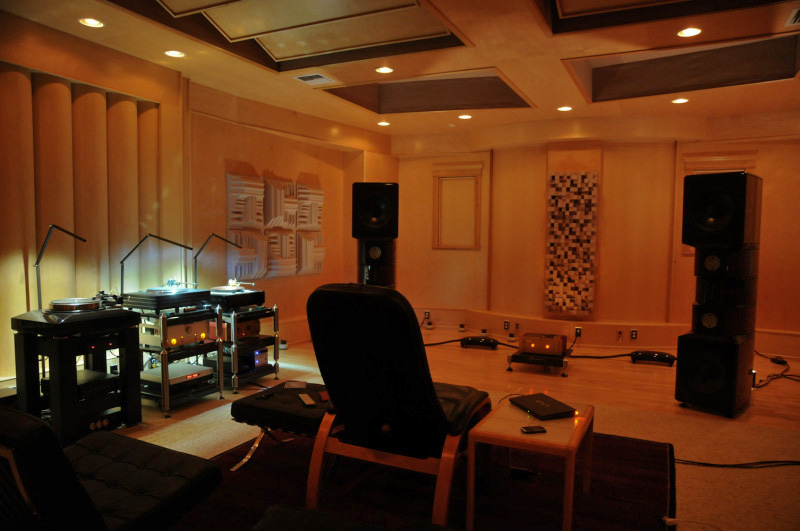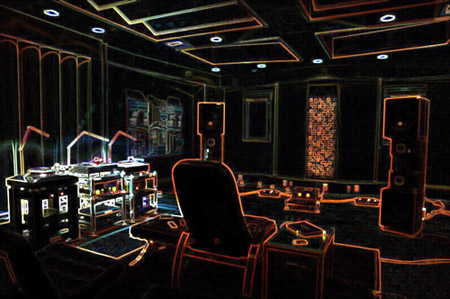-edible zone-
I managed to 'finagle' an invitation from Mike Lavigne to go over to his place and have a listen to his high end audio system in his converted barn. For details regarding the building construction of this purpose-built listening room link here: https://www.positive-feedback.com/Issue16/lavigneroom.htm
_______________horizontal rule
After the listening session was over, Mike asked me for some thoughts and analysis after I had had some time to consider all that I had heard. These are my notes to Mike and to myself for future reference.
3/12/2010
Hi Mike:
You did ask for my impressions,
thoughts, analysis, etc. So here they are:
I've had some time to
digest what I heard and thought it best to report before my memory,
already too short, begins to fail.
That room is just right in
dimension for what was going on. That is; listening to music with enough
volume (loudness) to get the full effect as intended by the musicians
and sound engineers that created those recordings. I didn't think to
bring along my spl meter but I'd estimate we were listening at 75- 85 db
much of the time and with peaks spiking up well into the 90's. High
enough to get the effect. Low enough not to cause hearing damage.
We started out with a request, from me, for Brubeck. You pulled out
the Classic Records 45 rpm "Time-Out" and played the disk with "Take
Five". First we heard it on the Garrard, then the SP10 mk3. In this case
the Garrard was truly impressive. What initially impressed me was the
excellence of the overall performance. (The system performance, not the
musicians, although the musicianship, as everybody knows, is excellent.)
Desmond's alto imaged itself in the space between the speakers and then
flew around a bit, seeming to duck behind the right speaker once in a
while, only to come out again and play. Desmond's tone quality, an airy
sweet highly refined sound ,no matter what it is played back through, in
this system had a warmth to it yet seemed natural full and solid.
Believable. Desmond was "there". Wright's bass was very strong. I think
I noticed / sensed the upper woofers of those Evolutions quite a
bit....in a truly positive way. Bass was strong, visceral and well
textured and defined. Not exactly tight, but not loose. Just right, I'd
think. It is odd that I tend to overlook the two key players in this
piece; Brubeck's piano and Morello's drums, but I better not take them
for granted. After-all, these are the guys laying down the odd beat time
signature, the very foundation of the track. In this case Morello's
cymbal work seemed extremely well defined, whole sweet, natural, sharply
defined and with good hang time/decay on the ringing tones. His snare
drum hits and foot pedal work, especially during the drum solo, produced
percussive sound waves carried forth with immediacy and a good bit of
energy. Brubeck's piano; yup he was there too but mostly in a supporting
role. (Without Brubeck, you don't get the Dave Brubeck quartet.) The
Ortofon MC A90, mounted on the Reed tonearm deserves much credit for
this reproduction. I'd also note that the A-90 seems to get acoustic
piano very well in addition to the other parts noted above.
Steve
Dobbins has done some good work on the Garrard 301. My first impression
is that --I wonder if I'll ever hear a better prepared Garrard than
this! With the Reed arm, the A-90 cartridge, played through the DartZeel
NHB-18NS battery powered preamp/phono-stage, The Loricraft motor
controller, power supply, and with upgraded bearing, Dobbin's plinth,
mods/upgrades, the new platter design, the Garrard becomes a machine
that can not only reproduce the energy and sense of drive that we expect
from an idler design of this type, but with a level of refinement and
detail reproduction that I did not expect. Impressive. Good stuff.
*
* The SP10 mk3. I'm disappointed that I did not get to hear this
player at its best. Unfortunately the new replacement cartridge (to
replace the broken Lyra Olympos..?) had too few hours on it for any
serious listening sessions. Additional note; I suspect that MC cartridge
loading on both the mk3 and the Rockport were not quite optimal. Perhaps
a matter of load settings switching on the back panel of the Alnic phono
stage being shared between them?
The music itinerary moved on to
some selections you made which were quite satisfactory for me. The
Albeniz....was it "Suite Espanola" , Decca SXL 6355, Speakers Corner
re-issue..? This one has me intrigued. I may have to find a copy for
myself. Then what was it...? ....something from Carmen, a re-issue of an
RCA recording, New Philharmonia Orchestra (forget conductor) , then a
few tracks off the "Take The A Train" Lp, a Japanese group recorded on
EMI/Toshiba. The one track we heard, I thought, was a really interesting
'small combo take' on that classic Ellington tune. I'll probably seek
out that Lp as well. Good listening there. I'm missing a few, I know but
there was a blues tune with John Lee Hooker and Miles Davis! , The
Doors, "Riders On The Storm", Van Morrison, "Into The Mystic". Huge
sounding reproductions of those performances. Excellent sounding
recordings. Then I requested another Doors tune, Willie Dixon's "Back
Door Man".
Most of this played on the Rockport which I sensed,
from my first listen, got closer to the the original master, and
therefore the musical truth than did the Garrard. However that
comparison isn't A to B due to the downstream electronics. Nonetheless,
The Rockport digs deep into those grooves and extracts more music, and
chunks of it that I suspect most of us haven't heard, even though we
know the records.
The tape. The Studer A820. What a beauty, both
in physical reality and in its sonic output. That sense of flow. The
ease with which it projects a wide dynamic at you. You only get this
from tape. Digital doesn't get it, though you'd think it would....in
theory. I'd love to hear the Studer after the "head stage' is complete.
*
Other thoughts part I:
Those Evolution Acoustic MM3 speakers
produce a very large sound field. Listening position was near field.
Just to frame it right, these speakers are tall. When seated, the upper
15 inch woofers are well above the listener's head. So, when I note that
the sound stage exists between the speakers, it implies a large amount
of space. Imaging is strong in this arrangement. With the volume boosted
up to near concert levels, the sound reproduction is very, very large.
This system can play "big". A truly entertaining and impressive musical
experience awaits those who listen in this room.
Other thoughts
part II:
I think at one point I posed the question, online in
public; Is it appropriate to put a modern arm and cartridge on an
ancient idler drive turntable. Would these mate well or would the
superior detail reproduction of modern high end tonearms and exotic MC
cartridges tend to reveal the weakness of the vintage designs? I think
I've been answered with regard to Steve Dobbin's work on that particular
Garrard 301. In that player you have the best of both worlds; details,
air and space combined with that sense of urgency and explosive output
as only an idler can do. However, in a more standard 301, I think my
question may hold more weight. In any case, the Reed tonearm has my
attention. And so too does the Ortofon A-90. Sexy to look at. There was
total immersion.
Other thoughts part III:
Every turntable
in that line-up was outstanding in terms of energy output. These
machines allow that sense of timing, that sense of immediacy and
explosive energy.
Other thoughts part IV:
The darTZeel
electronics is not too colored for my tastes. Solid state without any
aftertaste. Excellent transparency, speed and impact. What it does, I
really like.
Other thoughts part V:
Nice control over room
lighting. It inspires me to do some work on that front in my own room.
-Steve
end of notes
Equipment details as per this listening session
- Amplification: darTZeel NHB-108
- Preamps: darTZeel NHB-18NS with battery power and internal phono stage
- Speakers: Evolution Acoustics MM3 full range loudspeakers with powered woofers
- Source: Rockport Sirius III, Steve Dobbins prepared Garrard 301, Steve Dobbins prepared Technics SP10 mk3
- Source: Tonearms: Reed 2A, one for the Garrard and one for the SP10 mk3
- Source: Cartridges: Ortofon A-90, one for the Garrard, one for the Rockport
- Source: Reel to Reel tape: Studer A820
- Cables and interconnects: Nordost Valhalla ic, Jena Labs Fundamental One power cord, Transparent Opus MM Solid State speaker cable for bi-amping
- Support furniture: Grand Prix Monaco with Formula Shelves
*

 (hint: click thumbnail for full size image)
(hint: click thumbnail for full size image)








